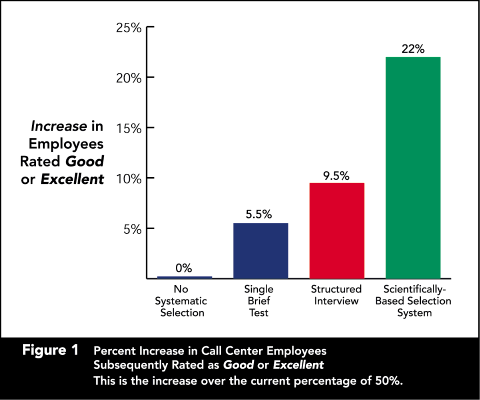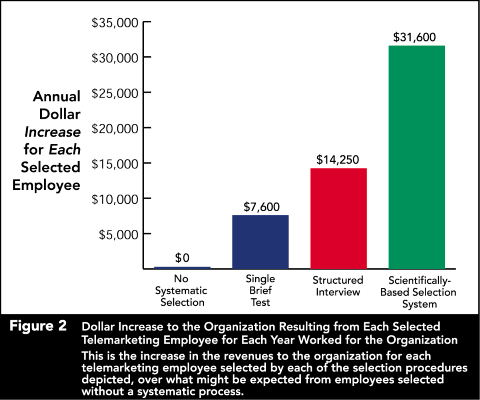
March 1999
Building A High-Performance Call Center Workforce
Through A Scientifically-Based Selection System
BY RALPH HAKSTIAN AND LINDA SCRATCHLEY,
HR DECISIONS LTD.
Workforce improvement has become increasingly important to managers in the recent years
of swift technological change and intensified competition. Nowhere is this concern more
pressing than in today's rapidly changing call centers. The two principal ways to achieve
such improvements are through careful personnel selection and on-the-job employee
effectiveness training. Training is often where managers focus most of their efforts.
Certainly, new-employee training - dealing primarily with systems and procedures - is
essential. Subsequent training interventions concentrating on "soft"
performance-enhancement skills, however, have had mixed reviews, and the ability of such
costly training programs to yield tangible workforce improvement has not been established.
If we shift our focus to personnel selection, though, we will see how the organization
that uses systematic pre-employment procedures lays a solid foundation for an ultimately
high-performing call center workforce, at a fraction of the cost of later training
interventions.
Pre-Employment Testing In Perspective
Some call center managers have simply disregarded testing at the personnel selection
stage, often as a result of myths which portray testing as inaccurate and somehow
dehumanizing. In addition, some managers avoid pre-employment testing because of negative
experiences with selection instruments that were too brief and ultimately worthless. The
marketplace abounds in examples of what we might term the "20-minute wonder" -
the quick and inexpensive general-purpose test. Single measures of this length and quality
can do more harm than good because the user, oblivious to the fact that such tests lack
the job focus, reliability and relevance to provide measurements of real value, may fail
to consider other, more valid, information in the hiring context. By using a systems
approach, however, the call center manager has access to far better pre-employment
assessment tools.
Over the past four years, we have been conducting research on how to best assess call
center applicants and predict success in this line of work. Let's take a look at what has
been learned.
1) Look for a selection system that is based on objective, focused research. This is
key. Always inquire about the amount and kind of objective research that has been
conducted with the test in the focused context of selecting call center employees.
Scrutinize the source of the research you review. In-house studies may contain inflated
statistics and errors of experimental design that could affect the results. Far better is
research published in the scientific literature, where the work must undergo rigorous
review by experts before it is published. The best assessment instruments and processes
meet this higher standard. Systematic research establishes the critical twin pillars of
reliability and validity:
- Reliability - How stable are the measurements? Are you getting a true and lasting
picture of applicants, or just how they appear today?
- Validity - How relevant are the measurements? Are you getting data truly related to call
center job performance, or merely information that seems reasonable, but, in fact, is
unrelated?
Reliability and validity determine the fairness, accuracy, usefulness and legal
defensibility of the assessment process. They can be established only by thorough
developmental research in a call center context, conducted by the supplier of the
assessment procedure long before its implementation in your center.
2) Look for a selection system that is comprehensive. This is where the notion of a
system comes in. No single test can provide a truly effective prediction of eventual call
center work performance, but a carefully researched set of key measures, properly
configured - an assessment system - can do so. We have found that the test battery
underpinning such a focused system takes between one and a half to two hours of testing
time to measure the relevant dimensions adequately. If this seems lengthy, keep in mind
that only those hoping to be hired are investing this time. In reality, and despite claims
to the contrary, it takes a battery this comprehensive to provide adequate measurement of
the key dimensions that accurately predict successful call center job performance.
3) Make sure the selection system measures the right dimensions. Related to
comprehensiveness is the question of what to measure, which is determined only through
systematic research. We found the following attributes crucial to telemarketer
effectiveness:
- Visual processing ability,
- Tolerance,
- Innovative thinking ability,
- Sociability and agreeability,
- Dominance,
- Perseverance,
- Orderliness,
- A strong sense for planning,
- A sense of well-being.
In our parallel research with telephone-service representatives, we found the following
dimensions critical in the prediction of successful work performance:
- Verbal skills,
- Tolerance and trust,
- Visual processing ability,
- Ethical standards and a social conscience,
- Creative thinking ability and resourcefulness,
- Non-extreme, conventional values,
- Self-control,
- An absence of cynicism,
- Conscientiousness,
- A sense of well-being.
All of the above-listed key dimensions can be measured in a well-designed test battery.
As seen from the above profiles, some attributes are important in both of the major
components of call center work.
The Organizational Benefits Of A Scientifically Based Selection System
In our research on call center employee selection, we calculated the benefits of this type
of selection system. Benefits have been indexed in two ways. Let's consider each of these
in turn.
- Increase the percentage of high-performing employees.
We compared the improvement in call center job performance that results from different
levels and kinds of personnel-selection procedures used in hiring. Improvement was defined
as the increase in the percentage of employees who would subsequently be rated as good or
excellent performers. The results, which appear in Figure 1, rest on two assumptions: (a)
that the current percentage (base rate) of call center employees (not selected by a
systematic process) demonstrating good or excellent performance is 50 percent, and (b)
that one employee is selected from four assessed (or 10 from 40, etc.).

The values in Figure 1 represent the increase - over the 50 percent base rate - in the
percentage of a call center's employees subsequently rated by their managers as good or
excellent. With a scientifically based selection system in place, for example, 72 percent
of call center employees would, in time, be so rated, in contrast to the 50 percent that
accompanies no systematic selection.
- Yield a substantial monetary gain for the organization.
We examined the dollar yield to organizations employing systematic selection of
telemarketing employees. Telemarketers were chosen because, unlike employees in many other
job categories, the results of their work are easily and naturally expressed in a dollar
metric. Our findings, which appear in Figure 2, again rest on two assumptions: (a) that
one employee is selected from four, and (b) that the average value of a single sale is
$50.

The values in Figure 2 represent the annual dollar increase per employee selected,
above the normal revenues generated by telemarketing employees hired without a systematic,
validated process. With a scientifically based system in place, for example, selected
telemarketers can be expected to generate $31,600 per year more than what can be expected
from employees selected without such a rigorous process (under the assumptions noted), and
this increased annual payoff continues for every year of the employee's tenure with the
organization. In a sales center that hires 50 new employees a year, this translates into a
$1,580,000 increase in revenues per year from scientifically based selection.
Conclusions
By using a scientifically based selection system, a call center can expect substantial
returns. With the cost of this assessment, which ranges from perhaps $150 to $350 per
employee hired, representing less than 1 percent of the additional revenues that the
employee selected this way will generate in one year, such a system should be seen as a
first-rate investment.
Adding a structured interview to such a comprehensive test-based selection system
increases the tangible benefits slightly over those depicted in Figures 1 and 2. In
addition, the balance provided by an interview improves both corporate public relations
and confidence among the hiring staff. For all of these reasons, we recommend that any
overall hiring program include an interview to augment the information gained from a
test-based selection system like the one described here.
Scientifically based selection ultimately comes down to obtaining and using all of the
reliable and relevant information available to you - in a systematic and scientifically
established way - to make the right selection decisions. When an organization makes this
its standard practice over an extended period of time, it is laying the foundation for
inevitable workforce improvement.
Ralph Hakstian is a principal of HR Decisions Ltd. and a professor of
industrial/organizational psychology at the University of British Columbia. He has more
than 20 years' experience designing personnel-selection systems for a variety of companies
and has published nearly 100 articles in the scientific literature. Linda Scratchley, a
senior psychologist with HR Decisions and a lecturer at the University of British
Columbia, specializes in personnel selection, performance management techniques and
creative management.
Founded in 1978 and based in Vancouver, British Columbia, Canada, HR Decisions Ltd.
designs and installs focused personnel-assessment systems for selection, promotion,
employee development and performance review at all organizational levels, and has
particular research-based experience with assessment systems in the telecommunications
industry. |